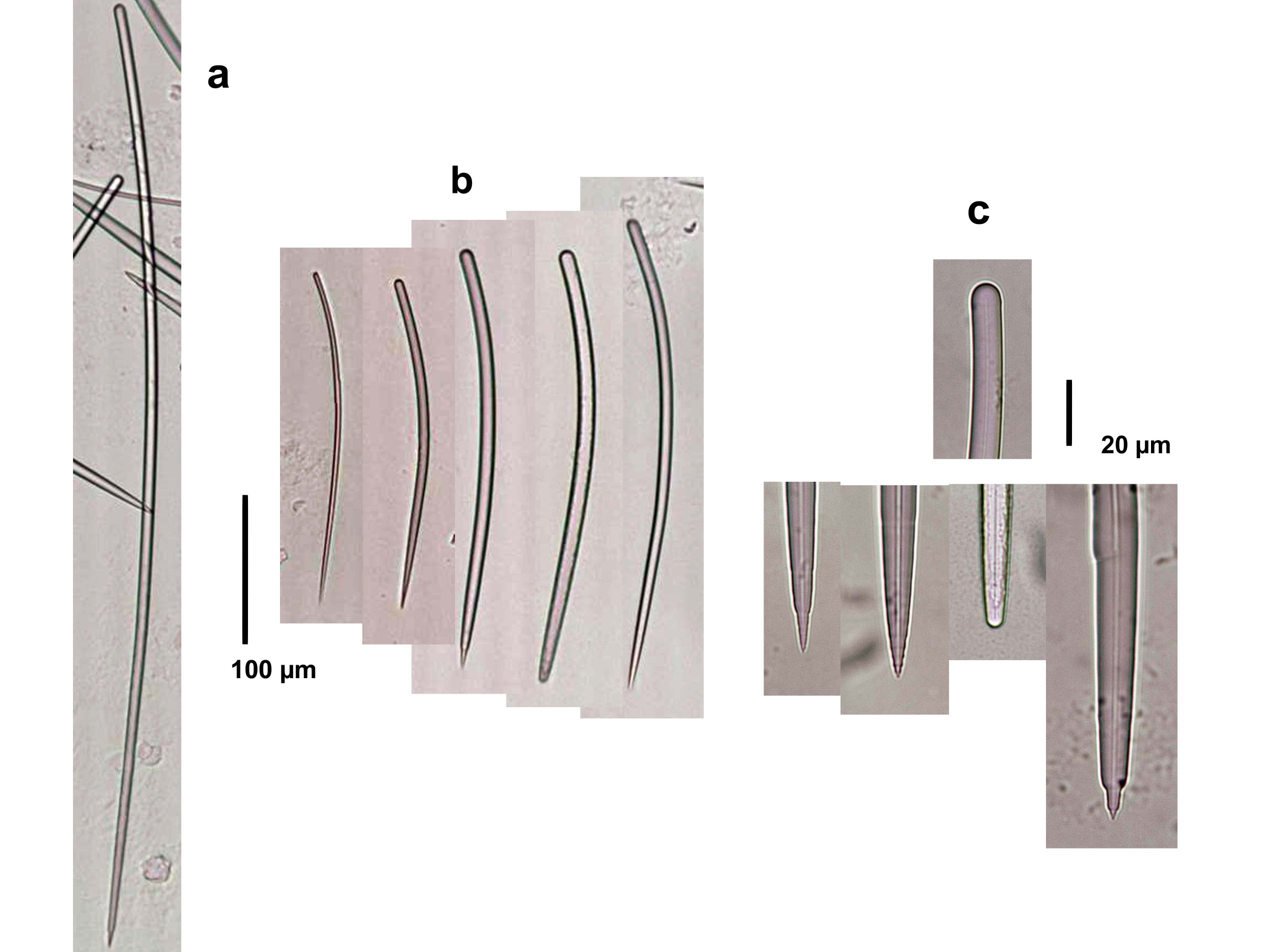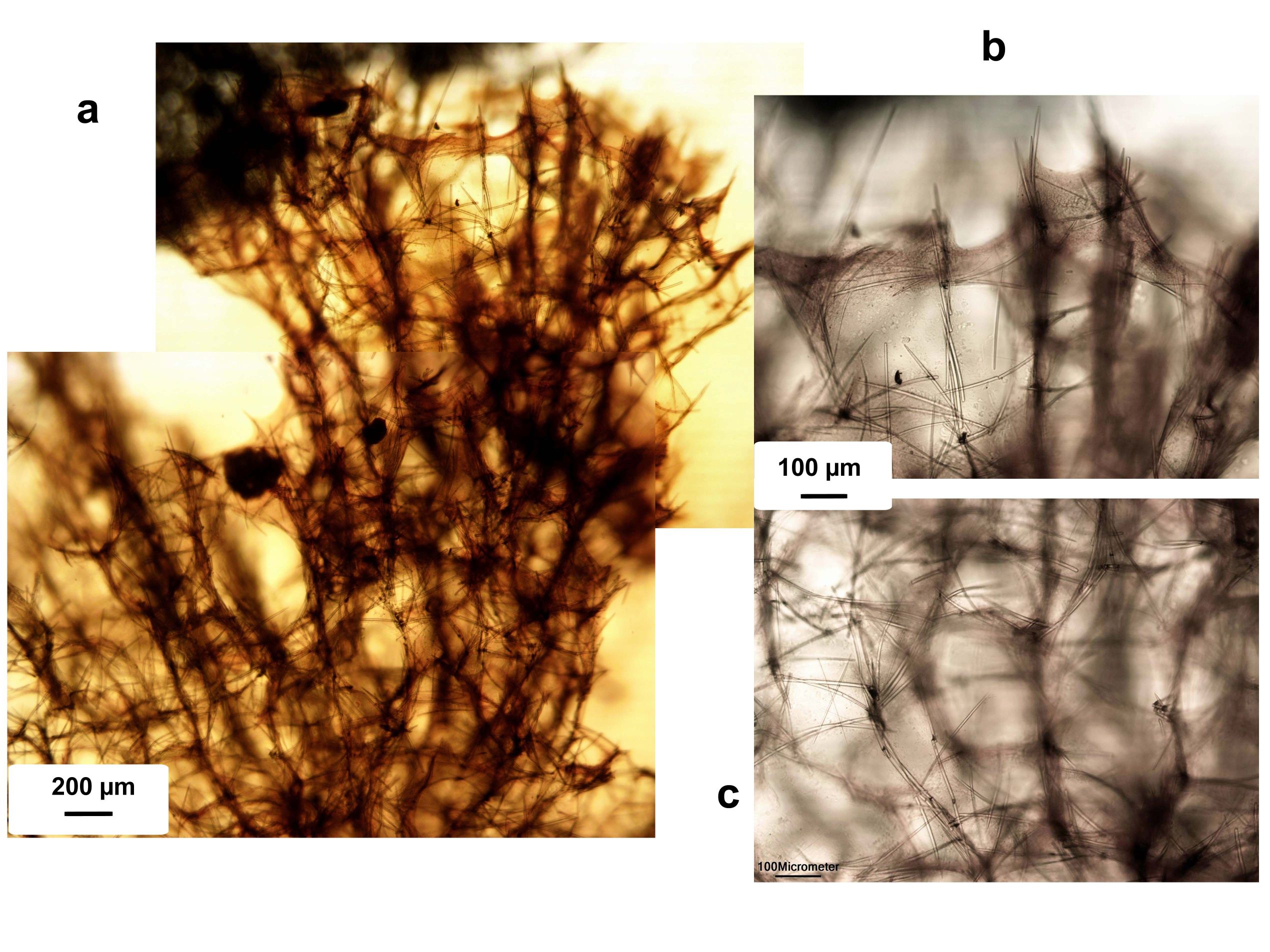the Sponge Guide - www.spongeguide.org
Observed Characteristics:
red
orange
orange-yellow
branching
bushy
fan
tough
Bahamas
Colombia
Puerto Rico
Species Description and Notes
Description: Cylindrical branches, single or divided; sometimes laterally fused conforming a fan; sometimes bushy. Size easily up to 50 cm high, branches usually 1-2 cm thick. Surface with spiny, round and blunt processes, hispid at the tips. Oscules not visible. Color scarlet red to orange to orange yellow; individuals at Santa Marta, Colombia, are always orange-yellow. Consistency tough, difficult to tear; branches elastic. Skeleton as ascending, diverging plumose tracts of 1-5 spicules, separated up to 100-120 µm, interconnected by single echinating spicules or by up to 4 spicule tracts, forming a rough, ladder-like reticulation. Spicules curved styles in two sizes: styles I, thin to thick-stout, with smooth heads and stair-stepped to rounded tips, 200-315 µm long by 5-12.5 µm wide; styles II, very scarce, long and slender, about 660 µm long by 8 µm wide (sizes are of Bahamian specimens). Size varies with geographically, spicules being larger in the continental coast of Colombia (styles I up to 494 x 29.5 µm, styles II up to 1290 x 16.8 µm) (Zea, 1987).
Notes: This species lives in shallow and deep reefs, in exposed substratum. It shows considerable variation in shape, but at a given locality it is usually rather constant in form. The regional variation in predominant color (e.g., always orange-yellow at Santa Marta and always red scarlet at Cartagena, both in Colombia) is intriguing. This species can be confused in the field with with P. marquezii (Duchassaing & Michelotti, 1864), also pictured here, with which coexists in some areas, but it is usually more orange and has flattened lamellae in the surface. They are also distinguished by spicules (oxea in P. marquezii, styles in P. walpersii). P. walpersii is also much more common. Can also be confused in the field with Higginsia coralloides Higgin, 1877, also pictured here, which has oxea and acanthomicroxea microsclere spicules.
Author Reference: (Duchassaing & Michelotti, 1864)
Link: World Porifera Database
Tissue and Spicule Images

Spicule Images: a) Styles II; b) styles I; c) ends of styles. Sample from the Bahamas.
Source Specimen: http://www.spongeguide.org/ thumbs/00078/00049.JPG
Spicule Images: Drawings of spicules (styles I and II) and of skeleton of specimens from Colombia. a) from Old Providence; b) from Islas del Rosario; c) longitudinal section of a branch, with the surface on left (from Zea, 1987, figure 67, as Ptilocaulis walpersi).
Source Specimen: http://www.spongeguide.org/ thumbs/00115/01864.jpg

Tissue Images: a) Longitudinal section of the body; b) magnification at the surface; c) magnification of the choanosome. Sample from the Bahamas.
No source specimen image available
Images
Ptilocaulis walpersii
Location: Bahamas, Stirrups Cays, N Berry Islands
Photographer: Sven Zea
Location: Bahamas, Cat Island, SW
Photographer: Sven Zea
Location: Bahamas, Sweetings Cay
Photographer: Sven Zea
Location: Bahamas, Sweetings Cay
Photographer: Sven Zea
Location: Bahamas, Sweetings Cay
Photographer: Sven Zea
![<i>Ptilocaulis walpersii</i> <br />[Bahamas, Stirrups Cays, N Berry Islands]](thumbs/00034/01135.jpg)
Location: Bahamas, Stirrups Cays, N Berry Islands
Photographer: Sven Zea
![<i>Ptilocaulis walpersii</i> <br />[Bahamas, Sweetings Cay]](thumbs/00041/01217.jpg)
Location: Bahamas, Sweetings Cay
Photographer: Sven Zea
Location: Bahamas, Northern Exuma Cays
Photographer: Micha Ilan
Location: Bahamas, Sweetings Cay
Photographer: Micha Ilan
Location: Bahamas, Sweetings Cay
Photographer: Micha Ilan
Location: Bahamas, Cat Cays - Bimini
Photographer: Sven Zea
Location: Bahamas, Sweetings Cay
Photographer: Sven Zea
Location: Bahamas, Sweetings Cay
Photographer: Sven Zea
![<i>Ptilocaulis walpersii</i> <br />[Bahamas, Stirrups Cays, N Berry Islands]](thumbs/00079/01834.jpg)
Location: Bahamas, Stirrups Cays, N Berry Islands
Photographer: Sven Zea
![<i>Ptilocaulis walpersii</i> <br />[Colombia, Islas del Rosario]](thumbs/00115/01864.jpg)
Location: Colombia, Islas del Rosario
Photographer: Sven Zea
![<i>Ptilocaulis walpersii</i> <br />[Colombia, Islas de San Bernardo]](thumbs/00115/01865.jpg)
Location: Colombia, Islas de San Bernardo
Photographer: Sven Zea
![<i>Ptilocaulis walpersii</i> <br />[Colombia, Islas del Rosario]](thumbs/00115/01866.jpg)
Location: Colombia, Islas del Rosario
Photographer: Sven Zea
![<i>Ptilocaulis walpersii</i> <br />[Colombia, Islas del Rosario]](thumbs/00115/01867.jpg)
Location: Colombia, Islas del Rosario
Photographer: Sven Zea
![<i>Ptilocaulis walpersii</i> <br />[Colombia, Santa Marta]](thumbs/00115/01868.jpg)
Location: Colombia, Santa Marta
Photographer: Sven Zea
![<i>Ptilocaulis walpersii</i> <br />[Colombia, Santa Marta]](thumbs/00115/01869.jpg)
Location: Colombia, Santa Marta
Photographer: Sven Zea
![<i>Ptilocaulis walpersii</i> <br />[Puerto Rico, La Parguera]](thumbs/00115/01870.jpg)
Location: Puerto Rico, La Parguera
Photographer: Sven Zea
Location: Colombia, Santa Marta
Photographer: Sven Zea
Location: Colombia, San Andrés Archipelago, San Andrés Island
Photographer: Sven Zea